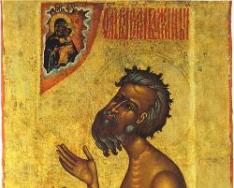Mother of God Alekseevskaya monastery, built in 1662, is considered one of the oldest operating Orthodox monasteries in southern Siberia. It is located in Tomsk on Yurtochnaya Mountain, at the mouth of the Bolshaya Kirgizka River. Here in 1658 a small wooden church in the name of Alexy was built God's man, but it was completely burned after a lightning strike. The first one was built in its place stone temple and the male monastery of the Mother of God Alekseevskaya was founded. At one time, it was this monastery that became the center of the spread of Orthodoxy throughout the nearby Pritom region.
The first Russian theological school in the city was founded within its walls. In 1776, a temple was founded in the monastery in honor of the Kazan Icon Mother of God, which became one of the first stone buildings in the city. For the bell tower at the temple, a huge bell was cast, which was called “Big.” Its weight is 300 pounds. The main shrine The temple is a carved shrine with the relics of St. Feodor of Tomsk.
Every Sunday in the church an Akathist to St. Theodore is performed, during which each believer is anointed with consecrated oil from a lamp burning in front of the tomb of St. Theodore. Despite the fact that in 1928 the entire territory of the monastery was completely placed under state protection, the bell tower was destroyed and the church itself was partially dismantled. Part of the territory was transferred to the jurisdiction of pedagogical school N2 and built up with new houses. The monastery and churches have been restored since 1979, but it is no longer possible to completely recreate its original appearance.
The ensemble of the Tomsk Mother of God-Alexievsky Monastery includes:
- Kazan Temple
- Chapel of St. Theodore of Tomsk
The monastery houses the relics of Elder Theodore of Tomsk, which have healing powers. In the temple there is a book testifying to the repeated healings of parishioners.
Kazan Church in the Tomsk Mother of God-Alexievsky Monastery
Story
Information about the time of the foundation of the monastery differs - according to some sources it was founded in, according to others - in year 1622. It is known that the monastery definitely existed in the 1630s. A. Latyshev explains such an early appearance of the monastery in the newly founded city by government decrees, and not by a large number of potential inhabitants who dream of retiring from the world. The original population of Tomsk consisted of riotous Cossacks, self-interested industrialists, foreign seekers of wealth, exiled Poles, exiled convicts, local Tatars, “whose customs pleased the Russians, and polygamy found imitators.” “The government saw how necessary a pious institution was in such a region, setting an example of Christian virtues...”
In the 1630-1650s, the Bogoroditsky Monastery was located at the confluence of the Kirgizka River with the Tom (Ust-Kirgiz Monastery). In 1658 moved to mountain_(Tomsk) Yurt mountain. During construction, underground warehouses and passages to the Ushaika River were built (workers who were doing excavation work stumbled upon the brick vault in early November 1888 in the courtyard of the head of the Tomsk treasury chamber, V.B. Orlov, who lived at the end of the street stretching from the monastery fence to the Ushaika River) .
In 1663, the church was consecrated in the name of St. Alexei, the man of God, the monastery began to be called the Mother of God-Alekseevsky.
The management of the other eight Siberian monasteries that were part of the Tomsk category was carried out from the Mother of God-Alekseevsky Monastery. Monastery before year 1764 and was the only owner of 400 in the Tomsk province serfs, and also owned land on the Tom and Ob rivers. In the 17th century, the monastery opened hospital, and in 1746 the first Tomsk school is the Tomsk Russian Theological School (in 1762 y converted to Russian-Latin). Also at the monastery with 1858 but acted theological seminary with an extensive library.
The monastery, like other Siberian monasteries, was a place links violators monastic charters. It also contained secular persons.
Mother of God-Alekseevsky Monastery- an Orthodox male monastery in Tomsk, is under the jurisdiction of the Tomsk diocese of the Russian Orthodox Church.
Story
Information about the time when the monastery was founded differs - according to some sources it was founded in 1605, according to others - in 1622. It is known that the monastery definitely existed in the 1630s. A. Latyshev explains such an early appearance of the monastery in the newly founded city by government decrees, and not by a large number of potential inhabitants who dream of retiring from the world. The original population of Tomsk consisted of riotous Cossacks, self-interested industrialists, foreign seekers of wealth, exiled Poles, exiled convicts, local Tatars, “whose customs pleased the Russians, and polygamy found imitators.” “The government saw how necessary a pious institution was in such a region, setting an example of Christian virtues...”
In the 1630-1650s, the Bogoroditsky Monastery was located at the confluence of the Kirgizka River with the Tom (Ust-Kirgiz Monastery). In 1658 it was moved to Yurt Mountain. During construction, underground warehouses and passages to the Ushaika River were built (workers who were doing excavation work stumbled upon the brick vault in early November 1888 in the courtyard of the head of the Tomsk treasury chamber, V.B. Orlov, who lived at the end of the street stretching from the monastery fence to the Ushaika River) .
In 1663, the church was consecrated in the name of St. Alexei, the man of God, and the monastery began to be called the Mother of God-Alekseevsky.
The management of the other eight Siberian monasteries that were part of the Tomsk category was carried out from the Mother of God-Alekseevsky Monastery. Until 1764, the monastery was the only owner of 400 serfs in the Tomsk province, and also owned land on the Tom and Ob rivers. In the 17th century, a hospital was opened at the monastery, and in 1746 the first Tomsk school - the Tomsk Russian Theological School (in 1762 it was transformed into a Russian-Latin school). Also, since 1858, a theological seminary with an extensive library operated at the monastery.
The monastery, like other Siberian monasteries, was a place of exile for violators of monastic regulations. It also contained secular persons.
The main monastery church is the Kazan Church, which also has chapels in honor of Alexy, the man of God and saints Florus and Laurus. The building was originally made of wood and burned down several times. In 1789, a modern stone church building was built in the Siberian Baroque style. In the church there was a particularly revered image of the Mother of God “The Burning Bush”.
In the 1830s, the monastery was surrounded by stone walls and chapel towers (designed by Tomsk architect K. G. Tursky). On the territory there was a garden, a lake, summer cells and a cemetery, and to the south of the monastery there was a monastery grove, which remained until the beginning of the 20th century.
New story
In 1922, the monastery itself was closed, but the community of believers at the Kazan Church existed until 1929. During this period, the monks lived under arrest in the fraternal building, and after the closure of the temple, together with the archimandrite, they were executed on Mount Kashtak.
In 1930, the Industrial Pedagogical Institute was located on the premises of the monastery.
By decision of the Tomsk Regional Executive Committee of February 17, 1978, the complex of monastery buildings was taken under state protection.
Modernity
In 1992, the Kazan Church and the cell building of the monastery were returned to the believers. Regular worship began. On July 5, 1995, in a cesspool on the site of the destroyed chapel of Fyodor Kuzmich, his relics were found, which became the main monastery relic. In 1997, the chapel of the saint was restored.
In 2010, in the cell building of the monastery (former building bishop's house, built in 1835 on the southern side of the monastery fence), the house was consecrated Church of the Three saints. It houses a marble iconostasis; the decor of the church itself is made in the Byzantine style.
In 2012, 15 million rubles were allocated from the federal budget under the Russian Culture program for the restoration of the Kazan Church.
Abbots
- 1605-1663 Ephraim (Berezovsky) pioneer
- 1660-1668 schema-abbot Isaiah
- 1698 Jonah the Greek
- 1901-1908 Archimandrite Jonah (Izosimov)
- 1999-2013 Abbot Silouan (Vyurov)
- since 2013 hegumen Kirill (Umrilov)
Famous personalities
In 1729, Abram Petrovich Hannibal spent several months in captivity in the monastery.
In 1991, Patriarch Alexy II visited the monastery territory.
Monastic necropolis
The grave of Fyodor Kuzmich (photo from the beginning of the 20th century)
It very likely existed from the first years of the founding of the monastery on Yurtochnaya Mountain, that is, from 1663. On maps of Tomsk, the necropolis in the monastery has been indicated only since the end of the 19th century. On the 1898 map it occupies a significant area to the north and east of the church. It is no longer indicated on maps of the 1930s.
In 1864, Elder Fyodor Kuzmich, identified in legends with Emperor Alexander I, was buried in the monastery cemetery. In 1904, a chapel was built over his grave according to the design of the architect Vikenty Orzheshko.
Famous residents of Tomsk were buried in the monastery cemetery; there were also graves of “those pious persons” who made contributions for the benefit of the monastery during their lifetime - gold miner I. D. Astashev, a fighter against the abuses of local officials, governor N. V. Rodzianko (among the city inhabitants there was a legend according to which a heart-rending cry could be heard from the grave for a long time: “I am you, rascals, on the 3rd point”), governors I. I. Krasovsky who suddenly died in Tomsk (a year later he was reburied according to his will in the Trinity-Sergius Lavra) and A. I. Laks (also reburied from Tomsk), actual state councilor A. V. Durov, historian and local historian K. N. Evtropov, etc.
During Soviet times, the necropolis was destroyed; the last burial here was made in 1925; in 1929, a decision was made to liquidate the necropolis and build a park in its place.
Now the necropolis is being restored, excavations have been carried out, which have made it possible to attribute some of the burials.
The Mother of God-Alekseevsky Monastery is an Orthodox male monastery in Tomsk, located in the jurisdiction of the Tomsk diocese of the Russian Orthodox Church.
The monastery was founded in 1605 at the mouth of the Kirgizka River on Yurtachnaya Mountain. He suffered from raids by Siberian peoples (Kalmyks, Teleuts, Kyrgyz). In 1656, the only monastery church of the Kazan Icon of the Virgin Mary was burned. After this, it was decided to move the monastery to a safer place on the banks of the Ushaika River. The construction of the new monastery was completed in 1663.
The management of the other eight Siberian monasteries that were part of the Tomsk category was carried out from the Mother of God-Alekseevsky Monastery. Until 1764, the monastery was the only owner of 400 serfs in the Tomsk province, and also owned land on the Tom and Ob rivers. In the 17th century, a hospital was opened at the monastery, and in 1746 the first Tomsk school - the Tomsk Russian Theological School (in 1762 it was transformed into a Russian-Latin school). Also, since 1858, a theological seminary with an extensive library operated at the monastery.
The monastery, like other Siberian monasteries, was a place of exile for violators of monastic regulations. It also contained secular people. Thus, at the end of the 1720s, Abram Hannibal (great-grandfather of Alexander Pushkin), exiled to Siberia on the orders of Prince Menshikov, was under arrest in the monastery.
The main monastery church is the Kazan Church, which also has chapels in honor of Alexy, the man of God and saints Florus and Laurus. The building was originally made of wood and burned down several times. In 1789, a modern stone church building was built in the Siberian Baroque style. In the 1830s, the monastery was surrounded by stone walls and chapel towers (designed by Tomsk architect K. Tursky). On the territory there was a garden, a lake, summer cells and a cemetery.
In 1864, Elder Fyodor Kuzmich, identified in legends with Emperor Alexander I, was buried in the monastery cemetery. In 1904, a chapel was built over his grave according to the design of the architect Vikenty Orzheshko.
In 1922, the monastery itself was closed, but the community of believers at the Kazan Church existed until 1929. During this period, the monks lived under arrest in the fraternal building, and after the closure of the temple, together with the archimandrite, they were executed on Mount Kashtak.
In 1992, the Kazan Church and the cell building of the monastery were returned to the believers. Regular worship began. On July 5, 1995, in a cesspool on the site of the destroyed chapel of Fyodor Kuzmich, his relics were found, which became the main monastery relic. In 1997, the chapel of the saint was restored.
Pilgrimage trips to the Mother of God-Alekseevsky Monastery in Tomsk
Photo: Mother of God-Alekseevsky Monastery
Photo and description
The Mother of God Alekseevsky Monastery in Tomsk is one of the city’s iconic landmarks. The monastery was founded in 1605 on the Bolshaya Kirgizka River, nine miles from the city of Tomsk. Then it was called Ust-Kirgizsky. Despite the fact that the monastery had very good reinforcement and was surrounded by defensive ditches, it was constantly subject to raids by Tatars and nomadic Kyrgyz.
In 1656, as a result of a fire, it completely burned down. wooden temple monastery In 1657, the monastery was moved to a new location - Yurt Mountain, Tomsk fort. In 1662, the first wooden three-altar church was built on the territory of the monastery in the name of the Kazan Icon of the Mother of God, with two chapels dedicated to the martyrs Florus and Laurus, and Rev. Alexy, a man of God.
In 1681, the monastery was one of the oldest Siberian churches, so Tsar Feodor Alekseevich took it under his personal patronage. In 1698, the first school in Tomsk was opened at the monastery. From the 17th century The city's first almshouse and hospital began operating here. In 1764, the Mother of God-Alekseevsky Monastery became one of the regular monasteries and was ranked in the third class.
First stone modern temple The monastery was founded in 1776. Three years later, the consecration of the side chapels took place, and in 1789 - the main chapel of the temple in the name of the Kazan Icon of the Mother of God. The Kazan temple was built in the architectural traditions of the Siberian Baroque school, becoming the first stone structure cities. On the territory of the Mother of God-Alekseevsky Monastery there is one of the oldest graveyards in Tomsk.
In the 1830s. Stone walls and chapel towers were erected around the monastery. The author of this project was the Tomsk architect K. G. Tursky. On the territory of the monastery there were summer cells, a lake, a garden and a cemetery, and to the south there was a monastery grove, which remained until the beginning of the 20th century.
In 1922 the monastery was closed. In 1941-1945. it was used as a military hospital. After some time, the monastery buildings, including the partially dismantled Kazan Church, were transferred to the Tomsk Pedagogical College. In 1992, the building of the Kazan Church and part of the cell building were transferred to the jurisdiction of the Tomsk Deanery of the Russian Orthodox Church. The monastery was restored practically from ruins.
Today, the Mother of God-Alekseevsky Monastery is one of the oldest operating Orthodox monasteries in the south of Siberia.
Signs of the zodiac


